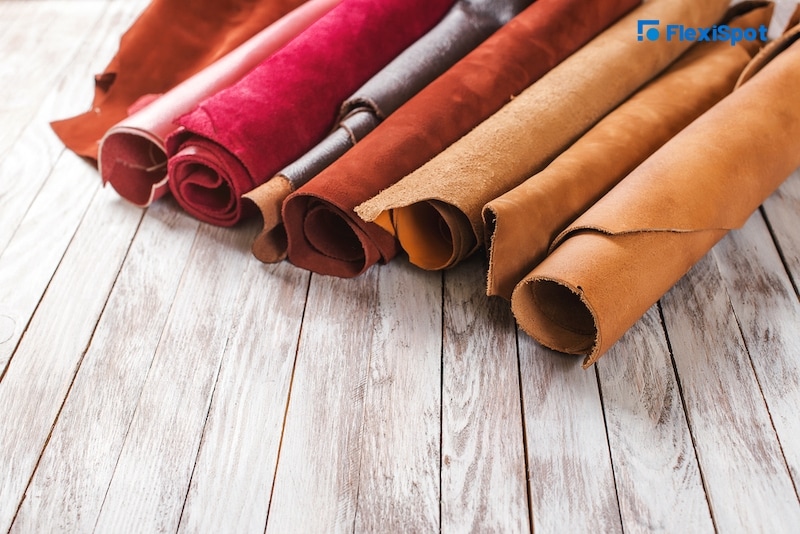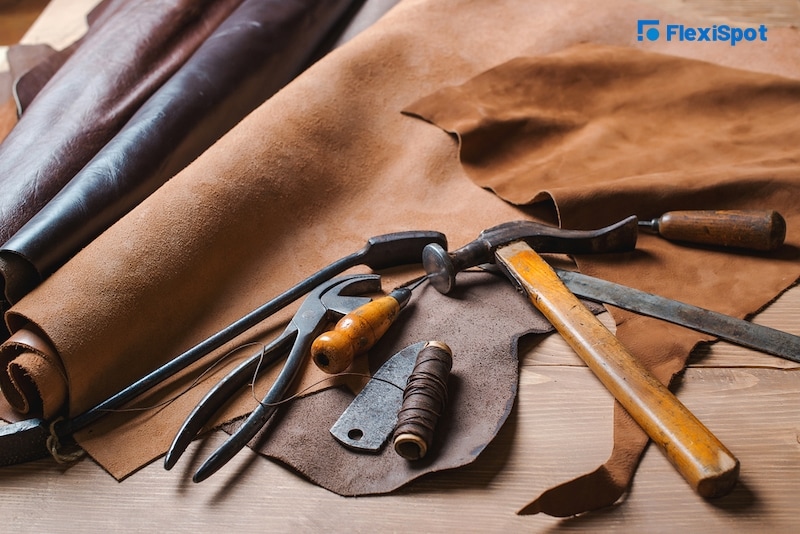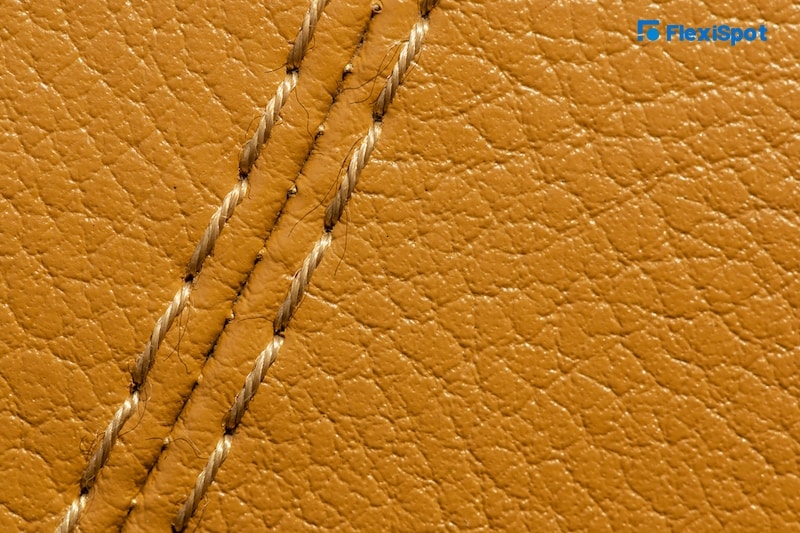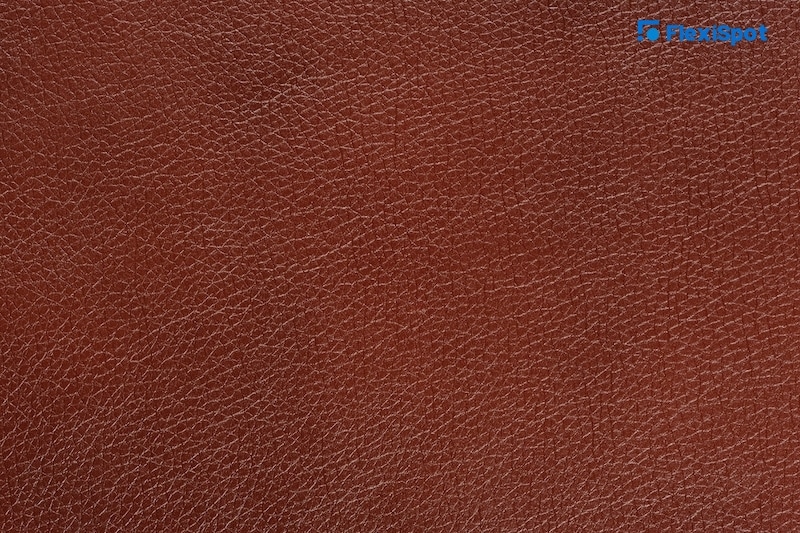If you’re looking to upgrade your workspace to a leather ergonomic office chair, you ought to first understand the different types of leather. There's a wide range of leathers available, including genuine, manufactured, synthetic, etc., leathers. Considering they all look and feel quite similar, it can be difficult to distinguish, let alone identify the different types of leather. Nonetheless, identifying the leather materials is critical, considering they have different attributes which influence their durability, sitting experiences, functionality, and more despite looking and feeling pretty much the same.
Bonded and faux are the most common types of leather materials on ergonomic office seats. Understanding the difference between these two varieties of leather is crucial in making informed decisions regarding the best leather office chair for your needs. Read on to learn more about bonded and faux leather ergonomic office seats as well as their differences.
Bonded Leather and Faux Leather
Bonded leather is not genuine leather as often advertised. Instead, it’s a type of leather made by milling leftover animal hides, shavings, and even dust and then binding them using glue on the back of a rigid fiber surface to provide the leather form. The finished product is then dyed and coated with polyurethane to give it a nice sheen, then embossed (etched with a leather-like roughness) to make it appear like real leather.
Bonded leather usually contains 10 to 20% recycled leather hide scraps, with the remaining materials being thin layers of polyurethanes or vinyl. These hide scraps are often chopped into tiny pieces, then mixed with adhesives and rolled into flat material. If you're keen enough, you'll rarely see or feel any real leather part of a bonded leather fabric, considering they are up to 90% vinyl or polyurethane.
Faux leather, on the other hand, is an artificial leather made of thermoplastic polymer. Also referred to as polyurethane leather, (PU) leather, vegan leather, and leatherette, faux leather doesn't contain any genuine leather components. It's made using synthetic materials such as polyvinyl chloride (PVC), polyurethane (PU), and polyester microfiber. A fabric backing made of either polyester or cotton is coated with the chosen synthetic material and then treated to resemble real leather.
The Differences between Faux and Bonded Leather
While both are not 100% real leather, faux and bonded leather have clear differences in terms of different attributes. While bonded leather furniture is cheap, they are barely durable, lasting anywhere from a few months to a few years. They peel and flake with time plus are difficult to repair if damaged. Faux leather can be more durable than bonded leather depending on the exact synthetic material, whether polyvinyl chloride (PVC) or polyurethane (PU). Here are the differences between faux and bonded leather based on different attributes, including versatility, durability, affordability, and more.
Constituent Materials
Bonded leather is made from bits of leather that are bonded together with adhesive. It usually constitutes 10 to 20% real animal hide as well as tiny bits of animal shavings and dust. The process is completed by embossing (stamping with leather-like roughness) and coating the leather form with polyurethane to give it a nice sheen and make it appear like real leather.
On the other hand, Faux leather doesn’t contain even the smallest amount of animal hide. It’s essentially a leather-like material created using composite polymers to mimic the texture and appearance of real leather.
In regards to constituent material, there are two main categories of faux leather: polyvinyl chloride (PVC) or vinyl faux leather and polyurethane (PU) faux leather. Vinyl faux leather is made from robust polyester fibers coated with either polyvinyl chloride (PVC) or plasticizers (phthalic acid). PU faux leather, on the other hand, is formed by coating polyurethane to fabrics such as polyester or cotton and then treating it to appear like genuine leather.
Affordability
While both bonded and faux leather are considerably more -affordable than genuine leather, they have price disparities. Bonded leather is slightly cheaper than faux leather, particularly because it constitutes a pretty thin layer of materials bonded to a thin paper of fabric backing. While faux leather is cheaper than genuine leather, it will cost a little more than bonded leather. However, note that the overall price may be dependent on other attributes of the leather furniture, including features, quality of construction, and more.
Durability
Since bonded leather is essentially made from a mix of scrap leather and polyurethane and then adhered to a thin fiber or paper backing, it's typically less durable compared to faux leather. Bonded leather is also more susceptible to cracking, peeling, and flaking compared to faux leather and can last anywhere from a few months to a few years, depending on the amount of real leather and the intensity of the product. Besides, they tend to fade with time, especially when exposed to direct sunlight.
While it's still prone to tears and punctures, faux leather offers a higher level of durability. Being peel and crack resistant, you should expect faux leather products to last a minimum of 2 years. What's more, faux leather is also resistant to staining and fading, providing plenty of benefits. However, it's important to note that PU and vinyl faux leather have different durability levels. Vinyl faux leather is more rigid and durable compared to PU faux leather, thanks to the additional layers underneath its coating. PU faux leather is softer and suppler than vinyl faux leather and doesn't crack or peel off quite easily as it lacks plasticizers found in vinyl faux leather.
Versatility
Both faux and bonded leather can be made in unlimited color, texture, style, and pattern combinations. However, faux leather is more versatile than bonded leather, considering that it is made from synthetic materials, which means it can be dyed in any color and finished to resemble almost any type of leather.
Texture and Feel
From afar, both faux and bonded leather appear like real leather. However, faux leather has a more consistent texture and has the closest resemblance to real leather, and may even look or feel like (smooth, soft texture) real leather in some instances. Bonded leather can sometimes look fake and synthetic, considering it has a thinner layer of leather compared to faux leather. Bonded leather is also less smooth, supple, and flexible compared to faux leather, depending on the amount of genuine leather in the chemical mix, which usually varies anywhere from 10% to 20%.
Emissions and Smell Differences
Both faux and bonded leather are not breathable but have differences in smell and emissions. Although smell is subjective and largely depends on an individual, faux leather has a slight synthetic smell of either plastic or chemicals while bonded leather does have an artificial odor but smells more or less like real leather owing to the addition of leather scraps. However, based on the amount of leather pulp in the chemical mixture, bonded leather will have varying degrees of plastic-like, chemical smell, or no odor at all.
In terms of emissions, bonded leather off-gas releases different chemicals, including leather toxins, into the atmosphere via evaporation. However, considering that they constitute a small percentage of real leather, the rate of off-gassing is minimal. Faux leather, on the other hand, tends to emit polyvinyl chloride (a colorless gas), polluting the environment and posing health risks.
Pros and Cons of Faux Leather
Faux leather has its fair share of benefits and drawbacks, as outlined below:
Pros
Cost-Effective- Faux leather is a much more affordable form of leather and appears more like genuine leather. It also lasts longer compared to bonded leather providing great value for money.
Durability- Faux leather is exceptionally robust and long-lasting, unlike bonded leather. It's less susceptible to scratching, peeling, and scraping, plus it’s stain and fade-resistant. A good-quality faux leather chair could last more than two years if taken care of properly.
Soft and Supple- Faux leather feels just like genuine leather; it’s soft and supple with great flexibility.
Vegan Leather- Faux leather is great for ethically minded persons concerned about animal rights.
Versatile- Faux leather can be made into different styles, patterns, colors, and designs based on specific needs.
Easy to maintain- Maintaining faux leather is less intensive and costly. It’s easy to clean, requiring only a nippy wipe using a damp rag.
Cons
Prone to tearing- Faux leather can tear or puncture quite easily, especially when handled inappropriately.
Not Breathable- Unlike real leather, faux leather cannot breathe freely owing to the outside coating. As such, it can get quite sweaty and uncomfortable, especially in hot weather.
Not Hypoallergenic- Faux leather is non-hypoallergenic, meaning that it can trigger an allergic reaction when you smell or get in contact with it.
Difficult to repair if damaged- Faux leather can be pretty hard to restore if torn, punctured, or cracked.
Non-biodegradable- Faux leather constitutes plastics as the main materials. Plastics are non-biodegradable and not environmentally safe.
Pros and Cons of Bonded Leather
Below are the benefits and downsides of bonded leather.
Pros
Cost-Effective- Bonded leather is pretty affordable, being cheaper than faux leather and authentic leather.
Versatile- Bonded leather can be made into any desirable style, color, and pattern depending on specific needs.
Easy to clean/ Resistant to Stains- Bonded leather is easy to clean and is also resistant to stains.
Decent Smell- Bonded leather may smell like genuine leather, depending on the percentage of leather scraps in the mixture.
Cons
Lower Durability-Bonded leather disappoints when it comes to durability. They easily tear and puncture, plus are more prone to peeling and cracking.
Difficult to repair- Once damaged, bonded leather is difficult to repair
Appears less like real leather- Bonded leather appears less like real leather. It is not as soft and pliable as authentic leather and is often difficult to work with due to rigidity.
Not breathable- Bonded leather doesn't breathe like authentic leather; therefore, it can get really uncomfortable in high temperatures.
Not Hypoallergenic- Bonded leather can cause allergies in people with sensitive skin as it is hypoallergenic.
Fades- Bonded leather fades with time, especially when exposed to direct sunlight.
Which Material is Better?
While it all boils down to personal preferences when choosing between the two types of leather, faux leather is a better material. While bonded leather is the most affordable type of leather, it has a short lifespan and appears less like genuine leather. Faux leather is a step above bonded leather in terms of durability, versatility, texture, and feel. Better yet, additional attributes, including being stain and fade resistant as well as less susceptible to cracking and peeling, make faux leather a far more desirable material. If you have to substitute real leather, faux is outright the best option to consider.
If you’re considering faux leather ergonomic seats, Flexispot offers great options and crazy discounts to meet your budget and specific needs. The Adjustable Ergonomic Leather Office Chair achieves impressive comfort thanks to the luxurious PU leather cladding, thick memory foam cushion, and enhanced ergonomic design. The Ergonomic Office Chair with Armrests Headrest and Lumbar Support 3361L is another great option constructed with Faux leather and this office chair features with adjustable height(44.5-48.2 inch) and rocking mode, you could adjust the seat height or rock the chair back and forth. An excellent chair fits for all workplaces like home, office, conference room and reception rooms.
Conclusion
Faux and bonded leather are the two major alternatives to real leather. While both have their fair shares of benefits and drawbacks, faux leather is highly recommended as it’s affordable, durable, and versatile. It offers great value for money and, when maintained well, can stand the test of time.
Of course, the ideal leather office chair for you depends on your budget and durability. If you're on a budget, bonded ergonomic office chairs can be the best choice but be prepared to replace them sooner or later as bonded leather has poor durability. On the other hand, if you're more concerned about durability and have a bit extra room in your tight budget, faux leather ergonomic seats offer a great combination of durability and price; such a decent option.
Now that you’ve understood the differences between the two forms of leather, you should be in a better position to make an informed decision as to which leather ergonomic seat is ideal for your specific prerequisites and applications.






